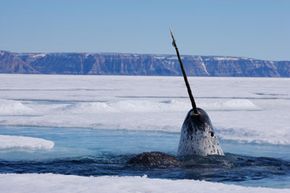Quck answer
Narwhals are unique Arctic whales known for their long tusks, which are actually elongated canine teeth. These tusks can grow up to 3 meters long and are used for various purposes such as hunting, social interactions, and even navigation. Narwhals are also known for their deep diving abilities, with some individuals recorded diving as deep as 1,800 meters. They feed on fish, squid, and shrimp, and are an important part of the Arctic food chain. However, climate change and melting sea ice are threatening their habitat, making conservation efforts crucial for their survival.
Wildlife

Arctic Animals Image Gallery A narwhal comes up for air in the Canadian Arctic. Check out more photos of arctic animals.
Paul Nicklen/National Geographic/Getty Images
When you think of unicorns, you may picture them as mythical creatures from fairy tales, but there is a real-life animal that resembles these majestic horned beasts: the narwhal.
Historians believe that the Vikings brought back narwhal tusks from their sea travels and sold them as unicorn horns, claiming that they had healing properties. Even though the existence of a unicorn was never proven, it was mentioned in the Bible, so denying its existence was considered heretical. People also believed that land animals had marine counterparts, so even if a tusked whale was discovered, it wouldn’t disprove the existence of a unicorn.
The narwhal has been shrouded in mystery for centuries, and stories of male narwhals engaging in jousting battles have circulated with little evidence to support them. Despite our limited knowledge of the ocean’s depths and its unusual creatures, we know that the narwhal is a unique, deep-diving, vocalizing whale that lives in cold-water environments and has a distinctive ivory crown.
The narwhal belongs to the Monodontidae group of odontocetes, which includes white whales and is known for its flat head and flexible neck. Toothed whales, including narwhals, have teeth, one blowhole, and a fatty organ called a melon in their foreheads that is used in echolocation.
Discovering Narwhals

A group of male narwhals gather at the Arctic ice edge to feed on cod in Lancaster Sound.
Paul Nicklen/National Geographic/Getty Images
The best place to find narwhals is in the Arctic Ocean off Canada, particularly in Baffin or Hudson Bay. They navigate polynyas, which are pools of open water in otherwise frozen environments, and use them as feeding grounds. These areas are also rich in marine organisms that serve as food for other arctic animals like birds, walruses, and whales.
The narwhal, also known as the “corpse whale” or “unicorn of the sea,” is easily identified by its long, spiral tusk. But how else can you spot these creatures? Adult narwhals have a dark gray or black and white mottled coloration, with some patches resembling livor mortis. Baby narwhals are gray without white patches, while old ones are completely white. Narwhals swim in groups, usually 20 or 30 at a time, but during migration, thousands can be seen together. They have a dorsal ridge instead of a fin, which makes it easier for them to swim under ice. Females weigh around 2,200 pounds, while males weigh 3,500 pounds. The tusk is a tooth that has grown upwards and pierced the lip, and the scientific name “Monodon monoceros” is actually incorrect since they have two teeth and no horns. Narwhals feed on fish like cod, salmon, herring, and halibut, as well as shrimp and squid. It’s unclear how many narwhals exist, with estimates at around 34,000 in certain areas. Narwhals have permasmiles and can live up to 115 years. They have big brains and display humanlike behavior, such as recognizing themselves in mirrors and understanding abstract ideas. Narwhals swim through deep waters in search of prey and use echolocation to locate objects.
Toothed whales produce sounds through their nasal passages and use their melon to focus the sounds into a beam before sending them out. The echoes bounce back to the whale and are received either in the lower jaw or directly in the skull, depending on the frequency of the sound. Different whale species have different frequency ranges for echolocation, with low-frequency sounds traveling farther and high-frequency sounds being best for short distances. Narwhals use echolocation to communicate and hunt, producing a combined pulsed/tonal sound. Their diving patterns vary depending on location and time of year, with narwhals diving deeper and longer during the winter in search of fish. The narwhal’s tusk is unique, with enamel on the outside and a sensitive pulp in the center.
The narwhal tusk is unique in that the soft, sensitive part is on the outside, while the dense, hard part makes up the middle. The tusk has ten million tiny holes on its surface, similar to human teeth, but without enamel. This means that the narwhal’s nerves are exposed in the icy waters of the Arctic, allowing it to detect water pressure, temperature, salinity, and possibly even barometric pressure. Dr. Martin Nweeia, a clinical instructor at the Harvard School of Dental Medicine, theorizes that the tusk acts as a sensor. However, it remains unclear why female narwhals do not have a tusk if it is so important for survival. The tusk’s sensitivity contradicts the idea that male narwhals use them to duel for dominance. Observers have reported that narwhals touch tusks in a non-violent way, possibly as a way of communicating. The tusk’s purpose may be related to mating, as almost all males have a tusk, while only 15 percent of females do. The narwhal is difficult to study, and much about it remains unknown. The narwhal tooth is the only straight tusk in the world, and it can grow up to 9 feet. The tusk is flexible and can bend a foot in any direction without breaking. The narwhal is under threat, like many animals.
In accordance with their traditions and culture, Inuit hunters are permitted to hunt a certain number of narwhals each year. Some of the more modern hunters use rifles, whereas others still use the traditional harpoon. Often, hunters will shoot a narwhal only for it to sink dead to the ocean floor or escape wounded. Although some countries have laws against the import and sale of items made from narwhal ivory, many other nations are happy to encourage the trade. Inuit hunters can make a considerable amount of money from a narwhal tusk, with double tusks selling for several thousand dollars. This is especially important in an area where jobs are scarce.
However, the narwhal is not just valuable because of its tusk. Inuits consume the top layer of skin and blubber, called muktuk or maktaaq, for vitamin C, which is difficult to come by in those regions. Unfortunately, eating marine mammals has become dangerous for the Inuit people due to high levels of PCBs and mercury found in animals around the ice cap.
Narwhals are not only hunted by Inuit hunters but also by orcas, polar bears, and walruses. Climate change is a significant concern for scientists studying the whales. Narwhals are highly dependent on their pack ice environment, and changes in sea ice have a significant impact on their migration patterns and survival. If the ice is too thick, narwhals can become trapped underneath it and may not be able to surface for air. If the ice is too thin, predators may find it easier to hunt them, and the narwhals’ fishy prey might move elsewhere.
It is difficult to determine how many narwhals there are in the world, and not knowing makes it challenging to figure out how many are disappearing. Environmentalists criticize the government’s imposed hunting quotas as too high, and the number of narwhals killed that sink to the ocean floor is not factored into the equation. By the time scientists determine whether or not climate change is killing them, it may be too late to do anything.
If you want to learn more about marine mammals, check out the related articles in HowStuffWorks, which include information on baleen whales, walruses, orcas, seals, sea lions, dolphins, and whales. Additionally, narwhal.org is an excellent resource for more information on narwhals.
list of sources about narwhals includes articles from a variety of publications, such as ScienceDaily, National Geographic, and Alternatives Journal. The articles cover topics ranging from the narwhal’s unique tusk to its diving behavior and longevity. The sources also discuss the threats facing narwhals, including noise pollution and warming waters due to climate change. Additionally, the sources explore the communication and echolocation abilities of narwhals, as well as their role in the Arctic marine mammal ecosystem. Overall, the list provides a comprehensive look at the current state of knowledge about narwhals from a range of perspectives and disciplines.
The document titled “Review of Significant Trade in the Narwhal (Monodon monoceros): A briefing by WDCS for the 20th meeting of CITES Animals Committee” is available on the CITES website at http://www.cites.org/common/com/ac/20/E20-inf-09.pdf.
FAQ
1. What are narwhals?
Narwhals are medium-sized whales that live in the Arctic waters of Canada, Greenland, Norway, and Russia. They are known for their unique, long tusks that can grow up to 10 feet in length.
2. How do narwhals use their tusks?
Scientists believe that male narwhals use their tusks to attract females during mating season. The tusks may also be used to establish dominance and for hunting prey, as narwhals have been observed using them to stun fish.
3. What do narwhals eat?
Narwhals primarily eat fish, squid, and shrimp. They use their sharp teeth to catch their prey and swallow it whole.
4. How do narwhals survive in the Arctic waters?
Narwhals have several adaptations that allow them to survive in the harsh Arctic environment. They have thick layers of blubber for insulation, and their skin is dark to absorb sunlight and keep them warm. They also have a specialized circulatory system that allows them to conserve heat.
5. How do narwhals communicate with each other?
Narwhals communicate using a variety of vocalizations, including clicks, whistles, and pulsed calls. They also use body language, such as head movements and tail slapping, to communicate.
6. Are narwhals endangered?
Narwhals are considered a species of “least concern” by the International Union for Conservation of Nature (IUCN), but they are still vulnerable to climate change and hunting by humans. In some areas, narwhals are hunted for their meat, skin, and tusks.
7. How long do narwhals live?
Narwhals have a lifespan of about 50 years in the wild.
8. Do narwhals migrate?
Yes, narwhals migrate seasonally to follow their food sources. They typically move north in the summer and south in the winter.
9. Are narwhals social animals?
Yes, narwhals are social animals and live in groups called pods. Pods can range in size from a few individuals to several hundred, with males and females forming separate groups.





Leave a Reply